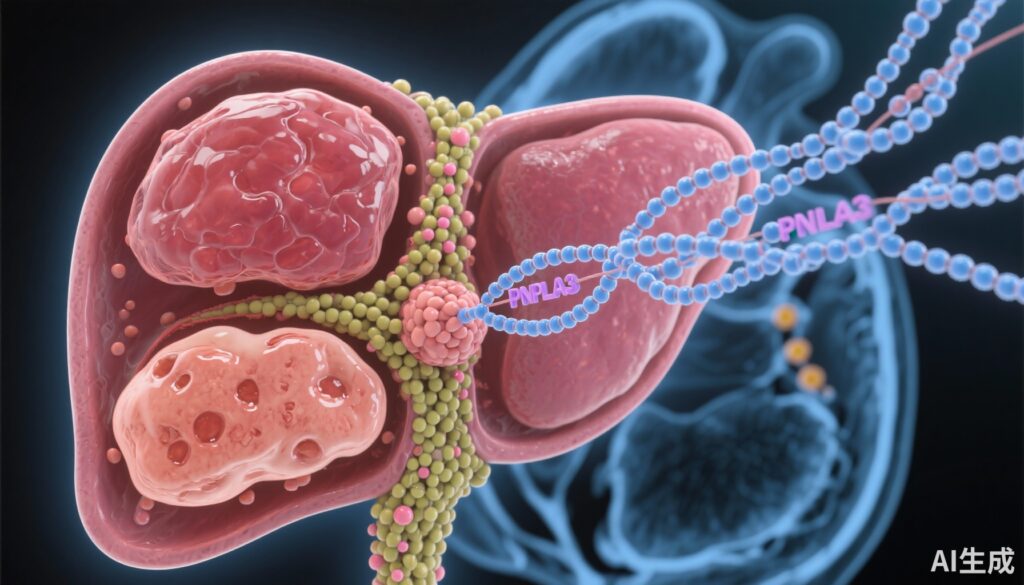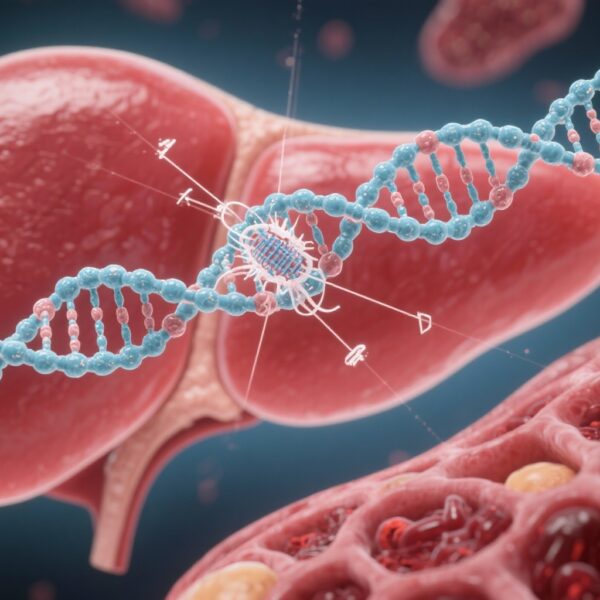Highlight
- AZD2693 effectively reduces PNPLA3 mRNA and protein levels in liver tissue of homozygous PNPLA3 148M carriers.
- The drug showed dose-dependent decreases in hepatic steatosis measured by MRI-PDFF with good safety and tolerability profiles in phase I trials.
- Treatment was associated with favorable systemic lipid modulation and reductions in inflammatory biomarkers.
- Supports the rationale for precision medicine approach targeting genetic risk in MASH; phase IIb trials are underway.
Study Background and Disease Burden
Metabolic dysfunction-associated steatohepatitis (MASH) represents a spectrum of non-alcoholic fatty liver disease characterized by hepatic fat accumulation complicated by inflammation and progressive fibrosis. MASH is a prevalent cause of chronic liver disease worldwide with limited approved pharmacological treatments. The progression to advanced fibrosis, cirrhosis, and liver-related mortality is influenced by both environmental factors such as obesity and insulin resistance, and genetic determinants.
A key genetic risk factor identified is the single-nucleotide polymorphism rs738409 in the patatin-like phospholipase domain-containing 3 gene (PNPLA3), resulting in an isoleucine to methionine substitution at amino acid 148 (p.I148M). Homozygosity for this variant correlates strongly with increased hepatic fat content, inflammation, fibrosis, and poor clinical outcomes, representing the largest common genetic effect known in MASH pathogenesis. Targeted inhibition of PNPLA3 expression thus emerged as a precision therapeutic approach.
AZD2693 is a liver-targeted antisense oligonucleotide designed to selectively bind and degrade PNPLA3 mRNA, thereby reducing pathogenic protein levels in hepatocytes. Early preclinical models demonstrated potent downregulation of PNPLA3 expression. This report summarizes two randomized phase I trials investigating the safety, pharmacokinetics, pharmacodynamics, and preliminary efficacy of AZD2693 in humans homozygous for the PNPLA3 148M risk allele.
Study Design
The investigation comprised two distinct phase I randomized, placebo-controlled, double-blind trials:
1. A Single Ascending Dose (SAD) study enrolled overweight to mildly obese but otherwise healthy volunteers, administering single AZD2693 doses ranging from 2 mg to 110 mg. Objectives included evaluation of safety, tolerability, pharmacokinetics, and dose-response effects on PNPLA3 expression.
2. A Multiple Ascending Dose (MAD) study recruited PNPLA3 148M homozygous participants with baseline liver fat fraction ≥7% by magnetic resonance imaging proton density fat fraction (MRI-PDFF). Participants received monthly doses of 25 mg, 50 mg, or 80 mg of AZD2693 over three months. Primary endpoints encompassed safety and tolerability; secondary endpoints included changes in liver fat content and target engagement measured by PNPLA3 mRNA and protein knockdown.
Complementary in vitro assessments were conducted using three-dimensional cultures of primary human hepatocytes homozygous for the PNPLA3 148M variant, and in vivo evaluation utilized transgenic mice expressing human PNPLA3.
Key Findings
Pharmacodynamics and Target Engagement:
AZD2693 demonstrated potent and dose-dependent knockdown of PNPLA3 mRNA and protein in cultured human hepatocytes and murine liver tissue. At the highest tested dose (80 mg), liver PNPLA3 mRNA levels were reduced by a least-square mean of 89%, substantiating effective target engagement in vivo.
Liver Fat Reduction:
In the MAD study, reductions in hepatic steatosis assessed by MRI-PDFF at week 12 were significant compared to placebo. Placebo-corrected least-square mean changes were -7.6% for the 25 mg dose and -12.2% for the 50 mg dose, indicating dose-responsive efficacy in reducing liver fat content. The MRI-PDFF metric is an established non-invasive quantitative biomarker for hepatic steatosis.
Inflammation and Lipid Profile:
AZD2693 treatment was associated with a favorable systemic biochemical profile, including dose-dependent increases in polyunsaturated fatty acids within serum triglycerides, which are considered metabolically beneficial. Additionally, markers of systemic inflammation such as high-sensitivity C-reactive protein (hs-CRP) and interleukin-6 (IL-6) decreased relative to placebo, suggesting anti-inflammatory effects.
Safety and Tolerability:
Both SAD and MAD studies showed AZD2693 to be generally well tolerated. There were no treatment-related serious adverse events or discontinuations due to adverse effects. The pharmacokinetic profile revealed a terminal half-life ranging from 14 to 33 days across doses, consistent with the intended monthly dosing regimen.
Expert Commentary
AZD2693 represents a novel therapeutic modality exploiting antisense oligonucleotide technology to modulate a genetically validated target with a large effect size in MASH pathophysiology. The phase I data provide compelling evidence of biological activity and safety in a genetically defined at-risk population. This strategy marks a move toward precision medicine where therapy is tailored based on patients’ genetic risk profiles.
Limitations to consider include the relatively small sample sizes and short duration inherent to phase I trials, which preclude firm conclusions on long-term safety and clinical outcomes such as fibrosis regression. Furthermore, while reductions in liver fat and inflammatory markers are promising surrogate endpoints, the translation into clinical benefit remains to be demonstrated.
Future studies should evaluate AZD2693 in larger phase II and III trials with extended follow-up, incorporating histological endpoints and harder clinical outcomes. The ongoing phase IIb FORTUNA trial will be critical to establish efficacy and safety in a broader MASH population enriched for PNPLA3 148M homozygosity.
Conclusion
AZD2693 effectively downregulates hepatic PNPLA3 expression with a favorable safety and pharmacokinetic profile in homozygous PNPLA3 148M allele carriers with metabolic dysfunction-associated steatohepatitis. The dose-dependent reductions in liver fat and inflammatory biomarkers highlight its potential as a precision-targeted therapy addressing a major genetic driver of MASH severity. These promising phase I findings justify further clinical development, with ongoing trials poised to define its role in the therapeutic armamentarium against MASH.
References
Armisen J, Rauschecker M, Sarv J, et al. AZD2693, a PNPLA3 antisense oligonucleotide, for the treatment of MASH in 148M homozygous participants: Two randomized phase I trials. J Hepatol. 2025 Jul;83(1):31-42. doi: 10.1016/j.jhep.2024.12.046 IF: 33.0 Q1 .
European Association for the Study of the Liver (EASL). EASL Clinical Practice Guidelines on non-invasive tests for evaluation of liver disease severity and prognosis. J Hepatol. 2021.
Anstee QM, Day CP. The genetics of NAFLD: Spotlight on PNPLA3. Nat Rev Gastroenterol Hepatol. 2015;12(5): 239-251.
Younossi ZM, et al. Global Perspectives on Nonalcoholic Fatty Liver Disease and Nonalcoholic Steatohepatitis. Hepatology. 2023.







